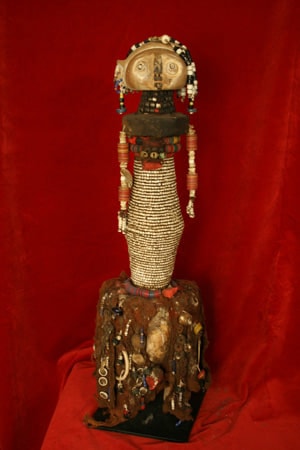Bagara or Ondurman Beaded Doll, 20th Century CE
Wood, beads, textile
FJ.0017 (LSO)
This attractive piece is a child’s doll, probably made by the Bagara or Ondurman people of Central Sudan. This attribution is based upon the elegant proportions of the piece, for...
This attractive piece is a child’s doll, probably made by the Bagara or Ondurman people of Central Sudan. This attribution is based upon the elegant proportions of the piece, for while it also resembles Sotho (Southern Africa), their dolls are usually smaller and less linear in design. This is an unusually impressive example. The head is mushroom-shaped with inset eyes, with a narrow neck, widening towards the abdomen then thinning to the waist. The body of the piece is decorated with white beads, the neck with dark bead necklaces and the arms rendered as strings of beads of alternating colours. The waist is circled with a belt of beads which sits atop a large collection of textiles, beads and other items that lend the appearance of a skirt. This, and the “pierced ears”, both suggest that it represents a female.
The term “dolls” is perhaps misleading for many African pieces that bear that name. In many cases the figures have a second, hidden meaning or significance. For example, Yoruba Ibeji dolls commemorate dead twins, and are not played with as such. Equally, Akan/Asante Akua’ba dolls are designed to attract fertility to the owner, and are also designed to train mothers-to-be in appropriate methods of care for children. They were also social indicators: in areas where beads were used as currency, a heavily beaded piece such as this would make certain statements about the status of the child and its parents.
This is a charming piece of African art.
The term “dolls” is perhaps misleading for many African pieces that bear that name. In many cases the figures have a second, hidden meaning or significance. For example, Yoruba Ibeji dolls commemorate dead twins, and are not played with as such. Equally, Akan/Asante Akua’ba dolls are designed to attract fertility to the owner, and are also designed to train mothers-to-be in appropriate methods of care for children. They were also social indicators: in areas where beads were used as currency, a heavily beaded piece such as this would make certain statements about the status of the child and its parents.
This is a charming piece of African art.
